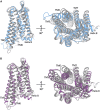Insights From Molecular Dynamics Simulations of a Number of G-Protein Coupled Receptor Targets for the Treatment of Pain and Opioid Use Disorders
- PMID: 31507375
- PMCID: PMC6716474
- DOI: 10.3389/fnmol.2019.00207
Insights From Molecular Dynamics Simulations of a Number of G-Protein Coupled Receptor Targets for the Treatment of Pain and Opioid Use Disorders
Abstract
Effective treatments for pain management remain elusive due to the dangerous side-effects of current gold-standard opioid analgesics, including the respiratory depression that has led to skyrocketing death rates from opioid overdoses over the past decade. In an attempt to address the horrific opioid crisis worldwide, the National Institute on Drug Abuse has recently proposed boosting research on specific pharmacological mechanisms mediated by a number of G protein-coupled receptors (GPCRs). This research is expected to expedite the discovery of medications for opioid overdose and opioid use disorders, leading toward a safer and more effective treatment of pain. Here, we review mechanistic insights from recent all-atom molecular dynamics simulations of a specific subset of GPCRs for which high-resolution experimental structures are available, including opioid, cannabinoid, orexin, metabotropic glutamate, and dopamine receptor subtypes.
Keywords: GPCRs; molecular dynamics; opioid crisis; opioid use disorder; pain.
Figures




Similar articles
-
Opioid receptors: Structural and mechanistic insights into pharmacology and signaling.Eur J Pharmacol. 2015 Sep 15;763(Pt B):206-13. doi: 10.1016/j.ejphar.2015.05.012. Epub 2015 May 14. Eur J Pharmacol. 2015. PMID: 25981301 Free PMC article. Review.
-
Insights into the function of opioid receptors from molecular dynamics simulations of available crystal structures.Br J Pharmacol. 2018 Jul;175(14):2834-2845. doi: 10.1111/bph.13774. Epub 2017 Apr 12. Br J Pharmacol. 2018. PMID: 28266020 Free PMC article. Review.
-
Mu Opioid Receptor Heterodimers Emerge as Novel Therapeutic Targets: Recent Progress and Future Perspective.Front Pharmacol. 2020 Jul 15;11:1078. doi: 10.3389/fphar.2020.01078. eCollection 2020. Front Pharmacol. 2020. PMID: 32760281 Free PMC article. Review.
-
Insights from molecular dynamics simulations to exploit new trends for the development of improved opioid drugs.Neurosci Lett. 2019 May 1;700:50-55. doi: 10.1016/j.neulet.2018.02.037. Epub 2018 Feb 18. Neurosci Lett. 2019. PMID: 29466721 Free PMC article. Review.
-
Neuropeptides and neuropeptide receptors: drug targets, and peptide and non-peptide ligands: a tribute to Prof. Dieter Seebach.Chem Biodivers. 2012 Nov;9(11):2367-87. doi: 10.1002/cbdv.201200288. Chem Biodivers. 2012. PMID: 23161624 Review.
Cited by
-
Mechanistic Understanding from Molecular Dynamics in Pharmaceutical Research 2: Lipid Membrane in Drug Design.Pharmaceuticals (Basel). 2021 Oct 19;14(10):1062. doi: 10.3390/ph14101062. Pharmaceuticals (Basel). 2021. PMID: 34681286 Free PMC article. Review.
-
Stereoselective recognition of morphine enantiomers by μ-opioid receptor.Natl Sci Rev. 2024 Jan 22;11(3):nwae029. doi: 10.1093/nsr/nwae029. eCollection 2024 Mar. Natl Sci Rev. 2024. PMID: 38410825 Free PMC article.
-
Neuroscience in addiction research.J Neural Transm (Vienna). 2024 May;131(5):453-459. doi: 10.1007/s00702-023-02713-7. Epub 2023 Nov 10. J Neural Transm (Vienna). 2024. PMID: 37947883 Review.
-
Activation mechanism of the human Smoothened receptor.Biophys J. 2023 Apr 4;122(7):1400-1413. doi: 10.1016/j.bpj.2023.03.007. Epub 2023 Mar 6. Biophys J. 2023. PMID: 36883002 Free PMC article.
-
Recent Chemical and Pharmacological Developments on 14-Oxygenated-N-methylmorphinan-6-ones.Molecules. 2021 Sep 18;26(18):5677. doi: 10.3390/molecules26185677. Molecules. 2021. PMID: 34577147 Free PMC article. Review.
References
-
- An X., Bai Q., Bing Z., Zhou S., Shi D., Liu H., et al. (2018). How does agonist and antagonist binding lead to different conformational ensemble equilibria of the κ-Opioid receptor: insight from long-time gaussian accelerated molecular dynamics simulation. ACS Chem. Neurosci. 10 1575–1584. 10.1021/acschemneuro.8b00535 - DOI - PubMed
-
- Ballesteros J. A., Weinstein H. (1995). “Integrated methods for the construction of three-dimensional models and computational probing of structure-function relations in G protein-coupled receptors,” in Methods in Neurosciences, eds Sealfon S. C., Conn P. M., (San Diego, CA: Academic Press; ), 366–428. 10.1016/s1043-9471(05)80049-7 - DOI
Publication types
Grants and funding
LinkOut - more resources
Full Text Sources
Miscellaneous

